AES New York 2018
Engineering Brief EB04
EB04 - Applications in Audio
Friday, October 19, 4:30 pm — 5:45 pm (1E11)
Chair:
Ivan Bourmeyster, Arkamys - Paris, France
EB04-1 Withdrawn—N/A
EB04-2 Description of the Single Note Database SNDB—Esther Fee Feichtner, International Audio Laboratories Erlangen - Erlangen, Germany; Bernd Edler, International Audio Laboratories Erlangen - Erlangen, Germany
Big and well-tagged databases are needed for many tasks in music information retrieval. Therefore we created the single note database (SNDB) containing over 30,000 single notes of 11 orchestra instruments by extracting and combining material of well-established databases. The ground truth was manually checked, corrected, and augmented. The result is a large and easy to handle database providing a reliable ground truth with a high variety for each class. Because of well-known original databases, new scientific results can be easily compared to earlier approaches. Here we show the benefit of the SNDB in a simple example. Moreover, we depict how the SNDB was created in the first place and how it can be conveniently reproduced from the original databases.
Engineering Brief 471 (Download now)
EB04-3 Not Presented—N/A
.
EB04-4 Why Can You Hear a Difference between Pouring Hot and Cold Water? An Investigation of Temperature Dependence in Psychoacoustics—He Peng, University of California, San Diego - San Diego, CA, USA; Joshua D. Reiss, Queen Mary University of London - London, UK
Studies have shown that listeners can distinguish between hot and cold water being poured based solely on sonic properties, yet the cause of this is unknown. This acoustic perception of temperature is an interesting aspect of multisensory perception and integration. In this paper a series of experiments were performed to investigate the characteristics of auditory information when water is poured at different temperatures into various containers. Based on the results, it attempts to find physical and psychoacoustic explanations for the phenomenon.
Engineering Brief 473 (Download now)
EB04-5 Introduction to Acoustic Meshes in Audio Applications—Jason McIntosh, SAATI, SPA - Appiano Gentile (C0), Italy
Acoustic applications utilize thin porous materials for a variety of reasons, the primary one being to provide an acoustic resistance. This resistance dampens acoustic modes, allowing the designer to control their behavior. However, to achieve consistent resistive damping requires a level of precision manufacturing not found in common materials. SAATI of Italy produces a broad range of specialty woven meshes for acoustic applications that achieve this precision through a highly controlled weaving process. Some understanding of the weaving process is helpful in guiding a designer’s choice of materials.
Engineering Brief 474 (Download now)
EB04-6 The Sound Diffusion Simulation Software Basing on Finite-Difference Time-Domain Method—Kamil Piotrowski, AGH University of Science and Technology - Kraków, Poland; Adam Pilch, AGH University of Science and Technology - Krakow, Poland
The aim of the project was to create an application that allows users to simulate acoustic wave propagation according to given input parameters. The program was based on MATLAB environment and most parts of it were designed using k-Wave toolbox, the package operating on a finite-difference time-domain method calculations (FDTD). The application enables to create a heterogeneous medium and measure sound pressure distribution in a simulated scenario. Separate program module contains time and frequency analysis of obtained waveforms and gives the user a possibility to visualize the results. What is more, the software also computes directional diffusion coefficient d in accordance with ISO 17497-2:2012 of defined sound diffusers and makes one independent from complex measurements in an anechoic chamber.
Engineering Brief 10075 (Download now)
